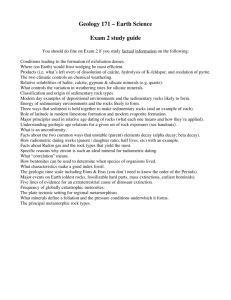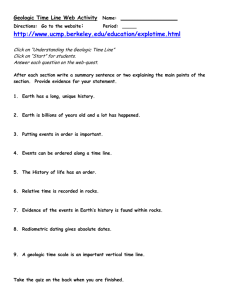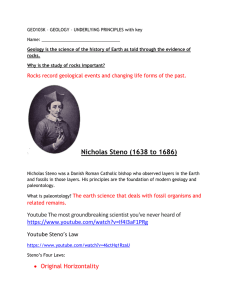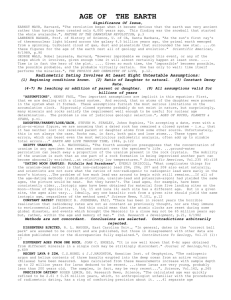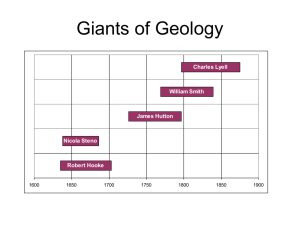science in the park: geology relative dating
advertisement
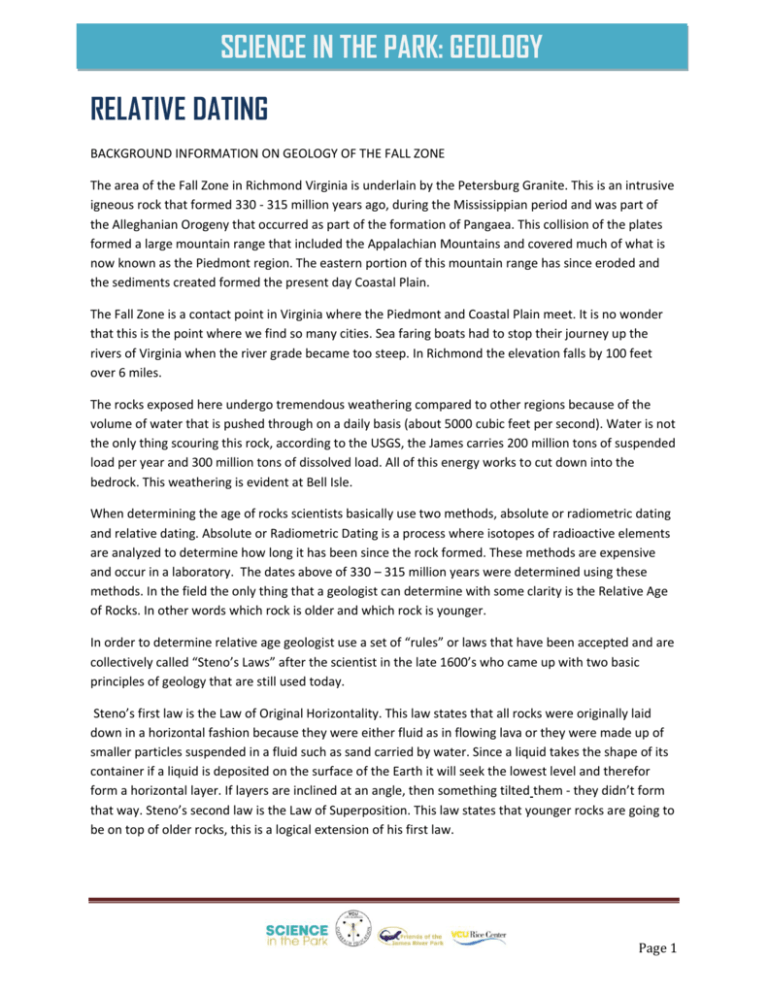
SCIENCE IN THE PARK: GEOLOGY RELATIVE DATING BACKGROUND INFORMATION ON GEOLOGY OF THE FALL ZONE The area of the Fall Zone in Richmond Virginia is underlain by the Petersburg Granite. This is an intrusive igneous rock that formed 330 - 315 million years ago, during the Mississippian period and was part of the Alleghanian Orogeny that occurred as part of the formation of Pangaea. This collision of the plates formed a large mountain range that included the Appalachian Mountains and covered much of what is now known as the Piedmont region. The eastern portion of this mountain range has since eroded and the sediments created formed the present day Coastal Plain. The Fall Zone is a contact point in Virginia where the Piedmont and Coastal Plain meet. It is no wonder that this is the point where we find so many cities. Sea faring boats had to stop their journey up the rivers of Virginia when the river grade became too steep. In Richmond the elevation falls by 100 feet over 6 miles. The rocks exposed here undergo tremendous weathering compared to other regions because of the volume of water that is pushed through on a daily basis (about 5000 cubic feet per second). Water is not the only thing scouring this rock, according to the USGS, the James carries 200 million tons of suspended load per year and 300 million tons of dissolved load. All of this energy works to cut down into the bedrock. This weathering is evident at Bell Isle. When determining the age of rocks scientists basically use two methods, absolute or radiometric dating and relative dating. Absolute or Radiometric Dating is a process where isotopes of radioactive elements are analyzed to determine how long it has been since the rock formed. These methods are expensive and occur in a laboratory. The dates above of 330 – 315 million years were determined using these methods. In the field the only thing that a geologist can determine with some clarity is the Relative Age of Rocks. In other words which rock is older and which rock is younger. In order to determine relative age geologist use a set of “rules” or laws that have been accepted and are collectively called “Steno’s Laws” after the scientist in the late 1600’s who came up with two basic principles of geology that are still used today. Steno’s first law is the Law of Original Horizontality. This law states that all rocks were originally laid down in a horizontal fashion because they were either fluid as in flowing lava or they were made up of smaller particles suspended in a fluid such as sand carried by water. Since a liquid takes the shape of its container if a liquid is deposited on the surface of the Earth it will seek the lowest level and therefor form a horizontal layer. If layers are inclined at an angle, then something tilted them - they didn’t form that way. Steno’s second law is the Law of Superposition. This law states that younger rocks are going to be on top of older rocks, this is a logical extension of his first law. Page 1 SCIENCE IN THE PARK: GEOLOGY Steno’s third law is the Law of Cross cutting Relationships. This law states that if a body of rock is cut by another geologic event then the rock must be older than the geologic event. Geologic events that affect rock include folding, tilting, faulting, and igneous intrusions. Steno’s fourth and final law states that rocks that are laid down horizontally continue until they run into another structure that impedes them. This is called the law of lateral continuity. These four laws earned Nicholas Steno the title of “Father of Stratigraphy”. For more information see http://www.ucmp.berkeley.edu/history/steno.html and/or http://www.britannica.com/EBchecked/media/159345/Stenos-four-laws-of-stratigraphy Page 2 SCIENCE IN THE PARK: GEOLOGY RELATIVE DATING Developed by C.P. Anderson Use the laws of Relative Dating to see if you can determine the age of the rocks in the picture below: From the North Geo Tour A – Petersburg Granite B – Igneous Intrusion X – Fault line Youngest _______ ________ Oldest ________ Page 3 SCIENCE IN THE PARK: GEOLOGY From the South Geo Tour Youngest ______________________ ______________________ Oldest ______________________ There are many areas where you can take your students out on the rocks and see similar examples of cross-cutting relationships. Encourage students to find areas where they can use these laws to determine relative age. Absolute Age of Rocks is determined by radiometric dating techniques that involve expensive equipment but with a little research into USGS documents you can form a general picture of the history of the Fall Zone here in Richmond. Page 4

